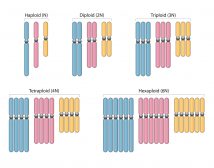Condenser
(Science: microscopy) in microscopy, the lens mounted before the microscope stage, which transmits light to the object. There are two main categories of condensers: (1) bright field and (2) dark field. Bright field condensers are of four distinct types: (a) Abbe condenser,, an uncorrected condenser composed of two separable lenses, (b) aplanatic condenser, (c) achromatic condenser which has full corrections for colour and spherical aberrations, (d) aplanatic achromatic condenser. The dark field condenser for low powers may be nothing more than a low-power bright field condenser with a central stop. Medium- or high-powered dark field condensers are usually of the cardioid or paraboloid type. The lamp lens is loosely called a condenser lens, but light-collecting lens is a more definite term. All microscope condensers must be carefully focused and aligned for best results.
Dictionary > Condenser
You will also like...

Polyploidy
Humans are diploid creatures. This means that for every chromosome in the body, there is another one to match it. Howeve..

Lights’ Effect on Growth
This tutorial elaborates on the effect of light on plant growth. It describes how different plants require different amo..

New Zealand’s Unique Flora
If New Zealand has lots of unique animals, it's also got a whole lot of unique plants. Find out more about some of them,..

Biological Viruses
Viruses possess both living and non-living characteristics. This unique feature distinguishes them from other organisms...

Origins of Life on Earth
Earth was created around 4.5 billion years ago and life began not long after. Primitive life likely possessed the elemen..

Pollution in Freshwater Ecosystems
There are many environmental factors that arise due to the usage of water in one way or another and for every action tha..

